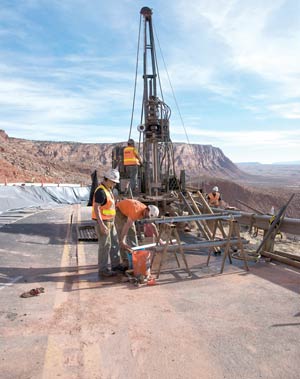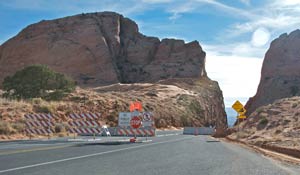Towns on detour disturbed by new traffic
By Krista Allen
Special to the Times
TS'AH BII KIN, Ariz., March 21, 2013


(Special to the Times – Krista Allen)
TOP: Geotechnical investigation is in operation as ADOT crews continue to install underground sensors Thursday afternoon to evaluate the landslide and monitor the stability of the site.
SECOND FROM TOP: The checkpoints at the north and south end of the landslide site are closed day and night to vehicle and pedestrian traffic.
W hile residents of Page, Ariz. are still reeling from a devastating landslide that caused about 150 feet of pavement to buckle more than a month ago in Bitter Springs, several nearby communities are concerned about the stream of traffic being diverted through their environs.
Locals here say they have observed numerous traffic violations and unsafe practices carried out by travelers driving on State Route 98.
Ts'ah Bii Kin Chapter President Martha Tate said March 10 at the chapter meeting that there is too much traffic.
"There's a lot of heavy motor vehicles going through," Tate said in Navajo. "I was observing one day - when drivers enter crossroads, they don't slow down."
The speed limit at the crossroad (between mileposts 349 and 350) is 55 mph. Tate says foreign motorists are driving about 80 mph through the area.
"They're going too fast," Tate said in Navajo. "I was driving to Shonto one day when a school bus came to a stop. As I came to a complete stop with two other vehicles behind me, a non-Native drove past us, passing the bus stop."
According to the Arizona Bus Stop Law, when approaching a school bus that is picking up or dropping off students, drivers must come to a complete stop before reaching the bus regardless of direction of travel.
"It's scary!" Tate exclaimed. "There's way too much traffic being diverted. That's why (the U.S. 89 landslide) needs to be repaired immediately."
However, it's going to take time to repair the road that collapsed right near the Antelope Pass Scenic Overlook at the Big Cut, which is in Congressional District 1, Legislative District 7 and Coconino County District 5.
Congresswoman Ann Kirkpatrick (D-Arizona) sent a letter to the U.S. Department of Transportation Feb. 25 in support of the Arizona Department of Transportation's request for emergency relief funds to repair the fractured section of the road.
"I am very concerned about the short- and long-term impact of the damage to U.S. 89," Kirkpatrick said in her letter.
Arizona State Rep. Jamescita Peshlakai, a Diné from Cameron, Ariz., urged Gov. Jan Brewer in a letter Feb. 26 to use emergency funds to repair and reopen a portion of the damaged road.
In the letter, Peshlakai asked Brewer to declare an official state of emergency and to release state money available within the Governor's Emergency Fund to stabilize, repair, and reopen the 23-mile long stretch of highway (from U.S. 89A junction to the SR 98 junction - mileposts 523 to 546) to Page as quickly as possible.
In addition, Peshlakai asked that officials consider using emergency money to pave Navajo Route 20, or Coppermine Road (between Bodaway-Gap and LeChee), and the 5.5-mile unpaved portion of Navajo Route 21 (between Tonalea junction from U.S. Highway 160 and Kaibeto) for alternative routes.
Several Western Navajo Agency chapters including Bodaway-Gap, Ts'ah Bii Kin and LeChee have supported immediate funding for the road construction of N-20.
"I suggested that (Kaibeto) take advantage of the situation," Kaibeto Chapter community service coordinator Peter June-Corbell said on Thursday. "I offered to the City of Page and (Coconino County District 5 Supervisor) Lena Fowler that N-21 through K'ai Bii' Tó could serve as an alternative tourist route and may recoup some of the lost tourist revenue that the city, Coconino County and the State of Arizona will be losing due to the shut down."
As a certified hotel administrator with a business degree, Corbell says he knows the thought process of tourists.
"They will choose another destination over a three-hour detour or delay," he said. "I proposed that Page, Coconino County, and (the State of Arizona) support Kaibeto to push the BIA roads to escalate the work currently in progress to finish the road before tourist season."
"Kaibeto will finally get N-21 paved and a good highway route from U.S. 160 through N-21 to SR 98 then on to Page - it will reduce the current time by half as well as mileage," Corbell continued.
Brewer issued a declaration of emergency on March 1 that was used to assist ADOT with seeking reimbursement from the Federal Highway Administration for necessary repairs to the roadway.
ADOT asked the FHA for the quick release of emergency funds following Brewer's declaration and that same day submitted an initial estimate of $35 million.
DOT secretary Ray LaHood announced on March 5 in Washington $2 million in quick release emergency relief funds to help repair the damage.
"President (Barack) Obama has said we need to 'Fix-it-First' and make sure our nation's transportation system is up to the task of supporting communities and businesses," LaHood said in a press release provided by the DOT's Federal Highway Administration. "When disaster strikes, the President's call to repair infrastructure becomes even more urgent."
In last month's State of the Union address, Obama proposed a Fix-it-First program to encourage public-private partnerships to fund transportation improvements in the country.
"Restoring transportation links after a natural disaster is critical to area residents as well as the economy," FHA representative Victor Mendez said in the press release. "This funding represents a down payment on our commitment to repairing this important highway."
According to ADOT, the quick-release funds will be used to assess the damage and the stability of the mountain slope and to conduct emergency operations. After the geotechnical investigation is complete, ADOT will submit a formal request to the Federal Highway Administration for additional emergency relief funds.
The current estimate is preliminary and could change.
Nevertheless, the detour route on SR 98 has caused the Inscription House Emergency Medical Services Field Office some great concerns.
Located at the Inscription House Clinic, the EMS office comprises nine basic life-support level emergency medical technicians and only two ambulances to cover the communities of Black Mesa, Kaibeto, LeChee, Navajo Mountain, Shonto, and Tonalea-Red Lake.
EMT Supervisor Julia Johnson said that she requested training for her crew and two personnel from the local Bureau of Indian Affairs Fire Department.
"Who will we call to help us if there should be a major incident such as mass causality (or a truck hauling) hazardous material from the extra traffic that is being rerouted to our area?" Johnson asked at the chapter meeting last Sunday. "This is not going to be the only emergency."
Johnson also requested from ADOT speeding enforcements to be placed at the crossroads to slow traffic down.
"We locals drive only at a low speed," Tate said.
While more drivers mean more traffic, Johnson says there could be possible drug traffickers on East U.S. 160 from Tuba City and on SR 98 to Page.
"We're not seeing it yet, but it's out there," she said. "They're probably going through here now. We won't know until it happens."
Johnson says there hasn't been an increase of vehicle accidents since the road closure.

